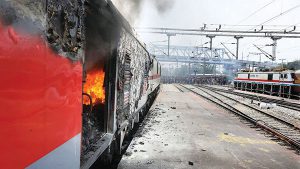Bloomberg
Protests continued across India for the second straight day over a shift in the army’s recruitment policy to short-term jobs, putting pressure on Prime Minister Narendra Modi who has pledged to boost employment in one of the fastest growing economies in the world.
Television footage showed crowds of protesters, who appear to be potential recruits, setting fire to train coaches and disrupting rail and road traffic. The protests come after the defense ministry unveiled a new policy that will see soldiers hired under a four-year contract and no pension entitlements.
Three days after the new policy was announced one protester died and over fifteen were injured in the southern Indian state of Telangana after police resorted to aerial firing to disperse the crowd, reported NDTV. The agitation spread across more states on Friday.
The protests had initially started in eastern Bihar state, Haryana in the north and the western state of Rajasthan, which are key recruitment regions for the army. The demonstrations turned violent in Haryana, with one government official injured on Thursday.
“There were protests in a few districts,†Sandeep Khirwar, a senior Haryana police official said. “The situation is under control.â€
Protests were also reported from Himachal Pradesh– another northern Indian state in the foothills of the Himalayas that shares a border with China. The military is the main employer in the region for thousands of young men who sign-up for service every year.
Over the past two years, the pandemic halted enlistment even after candidates cleared physical examinations.
151 long-distance trains were either canceled or delayed on the third day of the protest and as many as seven trains were torched, said Amitabh Sharma, a spokesperson of the Indian Railways.
The protests add to criticism that Modi’s government hasn’t done enough to bring down the elevated unemployment rate. Modi had pledged to create 10 million jobs a year as part of his election campaign in 2019 and this week, he was on a drive to recruit for one million government posts in 18 months.
While India’s unemployment rate has dropped to the lowest in three months, there are concerns that strong economic growth isn’t enough to create more jobs. Military enlistment was seen as a way to support the drive to employ more people.
Under a new policy called the “path of fire,†the Indian Army was to recruit soldiers in a bid to boost jobs and cut down pension bills that account for about a fifth of annual defense spending. About 3,000 men above the age of 17 will get enlisted and depending on their performance and requirements, more will be added.
Under the plan, which references a popular Hindi poem and Indian action drama, the recruits will train for six months, serve in the military for three and a half years but won’t be entitled to a pension when they leave. Traditionally, soldiers serve for about two decades with years of interspersed training and then retire with a guaranteed pension.
Pensions have steadily increased as retired officers push for higher payouts and benefits. In the current financial year, pensions accounted for about as much as 23% of the total defense outlay of $6.7 billion.
 The Gulf Time Newspaper One of the finest business newspapers in the UAE brought to you by our professional writers and editors.
The Gulf Time Newspaper One of the finest business newspapers in the UAE brought to you by our professional writers and editors.
